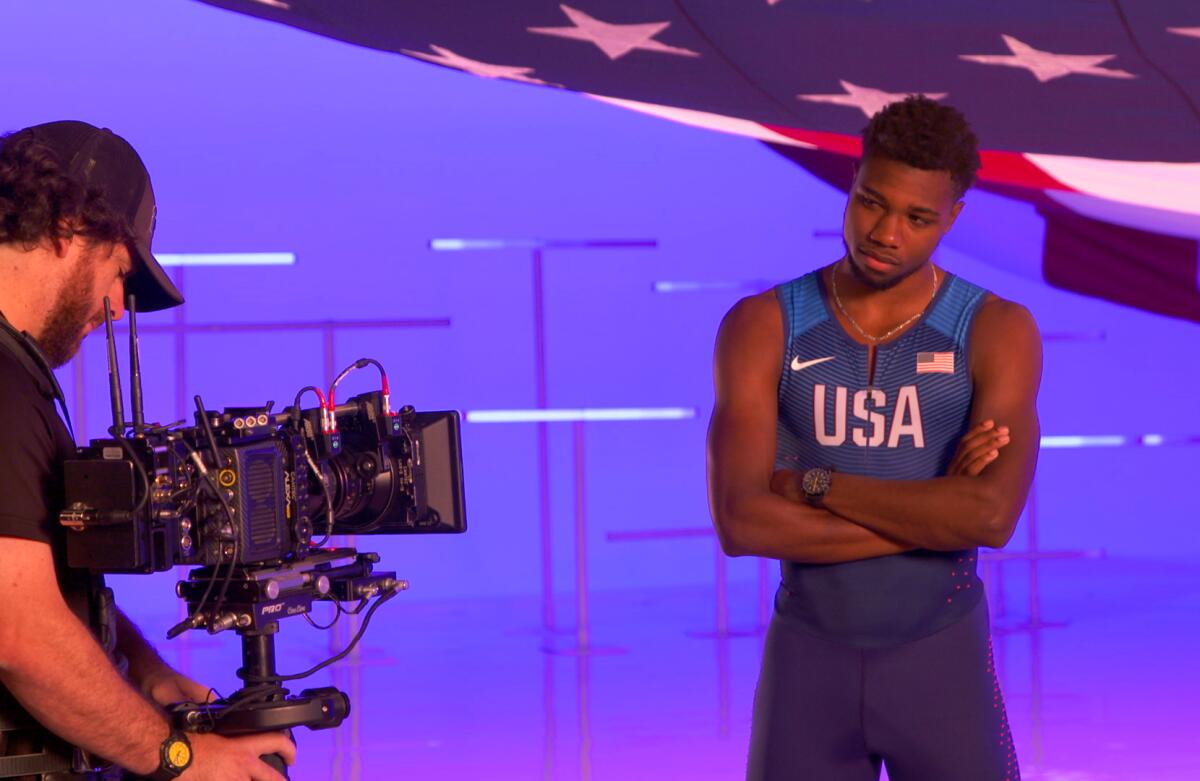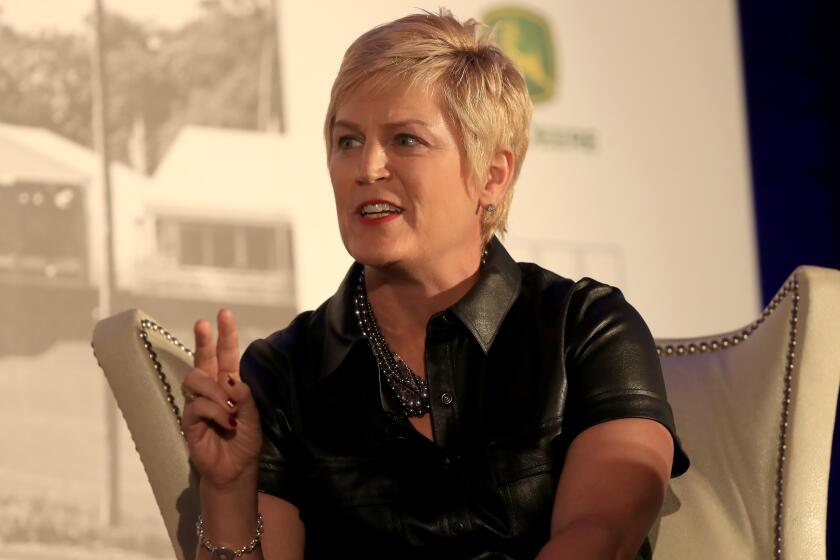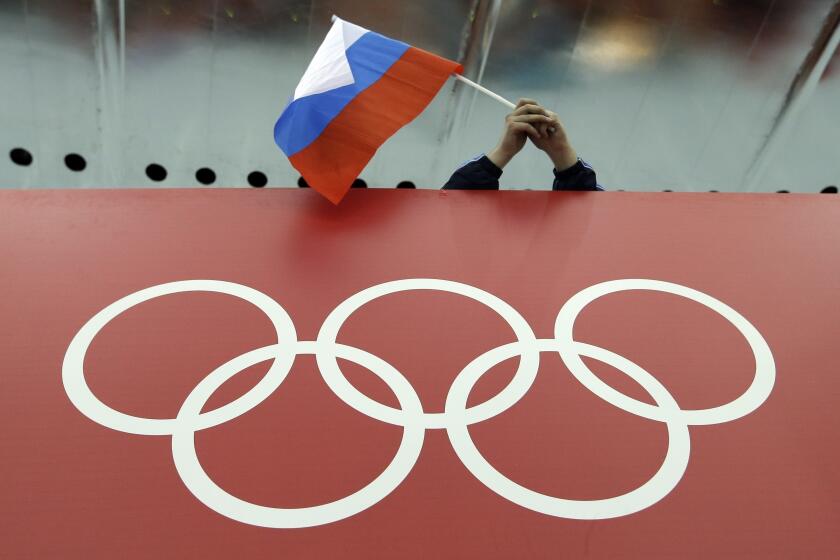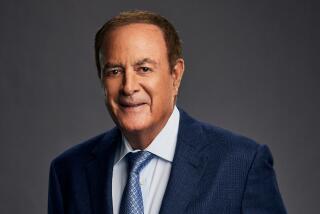It’s never too early for NBC to prepare for the 2020 Olympics in Tokyo

- Share via
It might seem like a shameless ploy, propping Allyson Felix in front of a camera with her baby daughter nestled in one arm and a puppy in the other.
As lights flash and a photographer clicks shot after shot, the American sprinter — a six-time Olympic gold medalist — doesn’t appear to mind. A smile widens across her face.
“This is fun,” she says.
With the 2020 Summer Olympics on the horizon, it is also serious business for NBCUniversal, which will blast 7,000 hours of coverage from Tokyo over multiple channels as well as digital and social media platforms.
Kevin Ellison was known for hard hits while playing for USC and the Chargers. Did that lead to increasingly bizarre behavior before his death?
The network recently summoned 110 U.S. athletes to a West Hollywood studio, shepherding them through soundstages, photo shoots and recording booths, taping interviews for use during the Games and, just as important, gathering raw material for ads and promos right now.
“We want people to see this and be talking about this,” says Jenny Storms, chief marketing officer for NBC Sports Group.
There is much at stake for a network that paid $7.75 billion for broadcast rights through 2032. The five-day “WeHo” session — nicknamed for its geographical location — was all about generating buzz that might translate into advertising revenue when the Olympics come around.
“They’re trying to make back a huge amount of money,” says Victor Matheson, a sports economist at College of the Holy Cross in Massachusetts. “And they’re trying to make it back in a world where people are consuming sports much differently than in the past.”
::
Tatyana McFadden has overcome congenital paralysis to win 17 medals at the Paralympics over the past 15 years, but the first time the American wheelchair racer showed up at WeHo was daunting.
“I was pretty nervous,” she says.
Athletes are greeted by handlers who guide them through a maze of 16 stations. Just past the check-in counter lies a cavernous soundstage where a 50-foot U.S. flag billows overhead and bright colors flash from a video wall in back. A “movement” coach helps with dancing for the cameras.
In other rooms, athletes give interviews, record snippets of video for social media and dress in their favorite outfits for a fashion shoot. Each room has its own producer and crew, encouraging athletes to show some personality.
Think of it as an elaborate introduction.
This isn’t like the Super Bowl or the NBA Finals, where viewers already know the major players. Olympic stars often toil in anonymity for years before making their Games debut.
NBC will borrow Molly Solomon, the head of the network’s Golf Channel, to oversee coverage of the 2020 Olympic Games in Tokyo next summer.
“It’s the story of ordinary to extraordinary,” Storms says. “The minute they get to Tokyo and they get on that medal stand, all of a sudden that person is a legend and America’s sweetheart.”
In search of an audience beyond the normal sports viewership, Olympic broadcasts have long relied on “up-close-and-personal” segments, using intimate stories to attract casual fans.
“Not a lot of us are hardcore gymnastics fans,” says Scott Minto, director of the sports MBA program at San Diego State. “That’s why the programming talks about human interest and there’s a lot of patriotism woven in.”
The WeHo event was born of a U.S. Olympic & Paralympic Committee summit that brings athletes and the media together shortly before each Games. Needing more content, and needing it earlier, NBC designed its “content capture” to function like an assembly line.
A daily, multicolored chart shows where each athlete should be at each moment. This tight schedule is the only way to keep things organized over the course of about 12 hours.
“When we say ‘on time,’ we mean that when the time is 12:08 and we’re done in that room, the athlete is leaving that room at 12:08,” Storms says. “The producers know there’s no ‘Oops, I’m running over, can I have a couple more minutes?’ ”
Network executives spend months determining the information they need. Each room has specific topics to cover, so athletes don’t have to answer the same questions over and over.
“A lot of different things happening,” Felix says. “It gets you thinking a lot and excited and you get to tell your story.”
::
It used to be that whichever network held Olympic broadcast rights would hold off on running promos until shortly beforehand, the idea being that viewers weren’t really interested until football, basketball and hockey seasons ended.
Besides, in the old days, the Summer Games were a guaranteed ratings winner.
But an increasingly fragmented media universe has taken a bite out of television, with so many entertainment choices on so many different platforms. Though sports broadcasts have remained relatively strong — “They’re one of the last things we still watch live,” Matheson says — even the Super Bowl has seen its ratings dip.
The same has been true for the Olympics.
NBC has responded with what Storms calls a “365-day” approach. The NBCSN cable network shows Olympic sports year-round while other channels look for opportunities to push the Games.
That means running promos during the Kentucky Derby. It means special segments on the “Today” show at the one-year and 100-day milestones. Sunday Night Football has already begun airing a spot with Simone Biles on the “flag” stage.
Anti-doping officials have proposed Russian be deemed “non-compliant” and banned from participation in the next two Olympic Games.
“We really pull out the stops,” Storms says, adding that “it has stitched the storyline together in more of a year-long fashion.”
The tactic doesn’t surprise Minto of San Diego State, who says “we’re not in 2020 yet and we’re already seeing it.”
Television is only the start of an all-out blitz. Camera crews shot video to show people waiting in line for rides at Universal Studios theme parks. In a world of Instagram and TikTok, content was tailored to social media.
“There will be people following these Games closely but not actually watching the Games,” Minto says. “They’ll be watching their Twitter feed. That’s where the younger eyeballs are now.”
::
Around lunchtime, Mike Tirico steps out front of the studio for a few minutes of fresh air.
As the man who will anchor NBC’s prime-time telecasts from Tokyo, Tirico sees this assignment as very different from his usual duties, hosting Football Night in America and calling play-by-play for Notre Dame football games.
Fans don’t need to be introduced to Irish quarterback Ian Book. The Olympics require a bit more work — it goes back to the notion that viewers won’t know some of the athletes who make headlines next summer.
“We carry the responsibility of telling stories about people that America wants to get to know,” he says.
During meetings with athletes and coaches, Tirico scribbles notes that might be useful during his nightly Olympic broadcasts. He sits down in a studio for one-on-one podcasts and short video interviews that will be streamed this spring.
“It’s another format to have out there,” he says.
There are also casual encounters, chats in the lunchroom and in hallways. During his midday break, he talks with Felix’s husband and brother, the three of them standing just outside a photo studio.
Felix is in there with daughter Camryn for the “puppy” shoot. These aren’t the sort of pictures that would normally appear on the sports page; instead, they pop up on Pinterest and in magazines such as People and Cosmopolitan.
And that’s precisely why NBC takes them.
More to Read
Go beyond the scoreboard
Get the latest on L.A.'s teams in the daily Sports Report newsletter.
You may occasionally receive promotional content from the Los Angeles Times.











